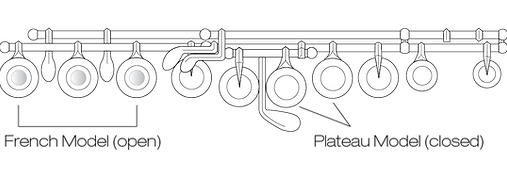

Orchestral Brögger Flute
Standard Specifications
Brögger Mekanik, Soldered Toneholes, Pisoni Pads, C# trill, Split E Mechanism, Half-Closing Thumb Key, and Gizmo (on B footjoint and convertible B/C footjoint).
Custom Specifications
Body Tubing: Sterling Silver (.014", .016", .018"), 10K Rose Gold, and 14K Rose Gold
Footjoints: B foot, Convertible B/C foot, C foot, D foot
G Keys: Inline, Offset, or Half Offset
Pitch: A-440, A-442, A-444, or A-446
Acoustic: Brögger or Traditional

14K Rose Gold Tube with Sterling Silver Mechanism

14K Rose Gold Tube with Sterling Silver Mechanism

14K Rose Gold Tube with Sterling Silver Mechanism
The Orchestral Brögger Flute is another design by Albert Cooper, our late Vice-President Emeritus. The goal of this design improves the intonation and response of the third register. Some players find that with the French Model flute, F#3 is resistant, A3 and A#3 are flat, and G#3 and C4 are sharp.
In Mr. Cooper’s own words, “The object of the alterations is to sharpen by varying degrees A3 and A#3, to flatten G#3 and C4, and to improve the attack of high E3, F#3, and G#3. This is an attempt to equalize the different qualities and flow of notes in the high octave both for tuning and attack.”
The Orchestral Brögger flute corrects these notes by incorporating three design changes:
• The left-hand keys are plateau (closed) while the right-hand keys are French (open). See illustration below.

• Several of the left-hand toneholes are changed in both size and placement.
• A half-closing thumb mechanism is incorporated. This mechanism makes the thumb key partially close when the G# lever is depressed.
Players will notice an immediate difference in response and overall consistency in the third octave. Large interval leaps are effortless and smoother. Therefore, the player is less likely to be caught in a harmonic. Soft passages require less effort, and fortissimo sections can be produced with more comfort and security. The overall timbre is full, rich and blends well with other instruments.
Like The Original Brögger Flute, this flute also uses the Brögger Mekanik, our signature pinless mechanism, the most highly regarded pinless mechanism on the market today! It solves two problems inherent in the traditional Boehm System flute:
• Misadjustment between certain keys in the “main line” - D to F#, E to F#, A to Bb; and
• Binding between the G and Bb keys on inline flutes.
These problems are solved using a patented pinless mechanism of bridges and full-size back connectors for the “main line” keys. The result is a much quieter flute with far less friction between and wear to its moving parts.
There are three distinctions or hallmarks of the Brögger Mekanik. First, the flutemaker can now independently regulate the spring tension of each key. The result is a more fluid feeling mechanism with spring tensions customized to a player's unique touch. Second, the adjustments are far more stable, resulting in less maintenance over the life of the flute. Less maintenance translates to both time and cost savings, along with the reliability required of an instrument for a professional career. Third, the strength of the mechanism is significantly increased, which is most appreciated during an accident. Almost 30 years of experience with the Brögger Mekanik proves that when dropped, the flute is far less damaged than a traditional Boehm flute would be.